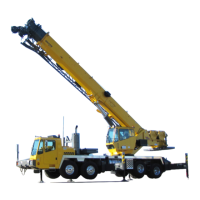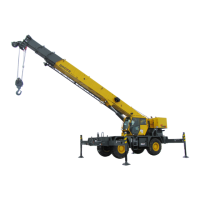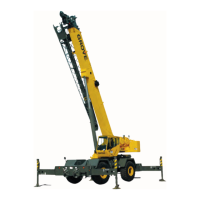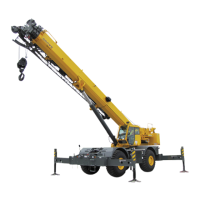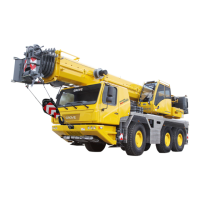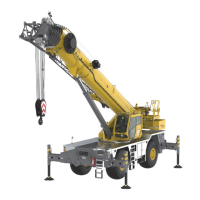Grove Published 02-21-2019, Control # 611-05 2-23
TMS9000-2 OPERATOR MANUAL SAFETY INFORMATION
The occurrence of an outrigger lifting from the ground is often
attributed to the natural flex in the crane’s frame. This may
happen when lifting a load in certain configurations within the
capacity limits of the Load Chart and is not necessarily an
indication of an unstable condition.
Provided the crane is properly set up, the crane is in good
working condition, that all operator’s aids are properly
programmed, that the qualified crane operator adheres to
the instructions found in the applicable Load Chart, Operator
Manual and decals on the crane, the crane should not be
unstable.
PILE DRIVING AND EXTRACTING
Pile driving and extracting are applications approved by
Grove, provided all equipment is operated within factory
guidelines. The following operating requirements must be
used during pile driving and extracting with a Grove mobile
hydraulic crane:
Pile driving and pile extraction using a mobile crane
introduces many variable and unknown factors that must be
considered when using a crane for this application. Because
of these factors, discretion must be exercised when pile
driving or pile extraction is being considered.
It is not the intention of Grove to recommend specific types
or makes of pile driving and pile extraction equipment, but
rather to advise of the operational requirements to help avoid
the detrimental effects that pile driving and pile extraction
can have on the crane.
In addition to the operating requirements that are detailed in
the operating manuals and on the load capacity chart, pile
driving and extracting operations are approved by Grove,
provided all guidelines outlined below are followed:
• All pile driving and extracting operations shall be
restricted to fully extended outriggers with all tires clear
of the ground.
• The combined weight of the driver or extractor, piling,
leads, attachments, etc., shall not exceed 80% of the
published load chart values for on-outriggers operation.
• The pile driver or pile extractor and attachments shall be
kept clear of the boom nose at all times.
• The pile driver and piling shall be suspended from a
hoist cable with sufficient line speed to meet or exceed
the rate of descent of the driver and piling to preclude
impact loading or vibration from being induced into the
boom and crane structure.
• Pile driving or extracting shall be restricted to over the
main boom only and shall not be permitted over a boom
extension.
• Pile extraction using only the crane’s hoist line is unsafe
and not permitted since load values cannot be
accurately determined. Only pile extraction devices that
do not transmit vibration or shock loading into the crane
are permitted. All possible precautionary measures shall
be taken to prevent shock loads or vibration from being
imposed on crane components, either directly through
the hoist cable or indirectly from ground borne vibration.
• The load lines shall be kept vertical at all times during
pile driving and pile extraction operations.
• The operator and other personnel associated with the
pile driving and pile extraction operation shall have read
and understood all safety standards applicable to crane
operations as well as being thoroughly trained in the
safe operation of pile driving and extracting equipment.
Crane Equipment
• Hoists shall be equipped with a cable follower to aid in
proper spooling of cable.
• All cable retainer pins and cable guides/retainers shall
be in place.
• All boom extensions must be removed from the machine
before pile driving or extraction begins.
• All hoist hooks shall be equipped with a positive locking
latch.
Crane Inspection
• In addition to the crane's frequent and periodic
inspections, dated daily records shall be maintained
showing inspections were performed on the crane
during the time it was used for pile driving or extraction.
• All anti-two block warning devices and RCL systems
shall be inspected daily and verified to be functional.
• All areas of the crane subject to fatigue shall be
inspected monthly, and before the crane is to return to
lifting service.
• The boom shall be inspected daily to ensure all wear
pads remain in place. Cranes which utilize pinned boom
sections shall be inspected daily to ensure the pinning
mechanism operates properly and to check for undue
wear at the pins and pinning plates.
• The hoist cable shall be inspected daily to ensure no
chafing or wear is occurring.
ELECTROCUTION HAZARD
Thoroughly read, understand, and abide by all applicable
federal, state, and local regulations regarding operation of
cranes near electric power lines or equipment.
United States federal law prohibits the use of
cranes closer than 6 m (20 ft) to power sources
up to 350 kV and greater distances for higher
voltages unless the line’s voltage is known
[29CFR1910.180 and 29CFR1926, subpart CC].
To avoid death or serious injury, Grove recom-
mends that all parts of crane, boom, and load be
